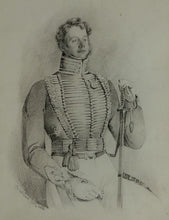Royal Horse Artillery - Portrait of a Waterloo Officer by Daniel Maclise, R.A., 1826
- Regular price
- £1,400
- Sale price
- £1,400
- Regular price
-
- Unit price
- /per
Adding product to your cart
Overall: 45cm (17.5in) x 37cm (14.75in)
Pencil on paper. Half length portrait of a a Royal Horse Artillery Officer wearing the Waterloo Medal on full dress dolman with closed collar, gold cord frogging and three vertical rows of ball buttons to the front, a barrel sash around the waist, his gloved left hand resting on the pommel of his sword. Signed and dated 'July 1826’. Image size: 25cm (9.75in) x 19cm (7.75in).
The present work pre-dates the young Daniel Maclise’s arrival in London where he was to paint the notable literary figures of his day, and, at the request of Prince Albert, execute his famous Waterloo and Trafalgar murals for the Palace of Westminster. The sitter in our pencil portrait was thus unusually fortunate to sit to then undiscovered talent of the young Maclise, perhaps as a way of commemorating his part in the titanic land battle that ended Napoleon’s dream of a Europe as a supranational entity.
Read More
The Duke of Wellington for his part was generally dissatisfied with the Royal Artillery’s performance at Waterloo. He stated ‘I would have had no artillery for the second part of the battle if I had not formed a reserve at the beginning.’ This reserve consisted exclusively of Horse Artillery, and it performed well despite little acknowledgement of the fact. Moreover, it has been said ’With the exception of 2 or 3 artillery officers who had served him well in the Peninsula, such as Frazer and Dickson (both of the R.H.A.), the Duke was particularly cool towards gunner officers. In fact the corps as a whole found it unusually hard to win [his] praise, or even recognition.’
Born in Cork, Ireland in 1806, Maclise showed a prodigious talent for sketching from a very young age. His father, who had previously served in the Army, ran a tanning and shoemaking business, but the young Maclise was encouraged by local collectors and amateur artists to pursue his talents, and he enrolled at the Cork School of Art before moving to London in 1827 to attend the Royal Academy Schools. In the 1830s and 1840s he exhibited regularly, mainly showing subjects from British history and Shakespeare. In London, Maclise mixed in literary circles and became a close friend of Charles Dickens and Benjamin Disraeli. He was in great demand as a book illustrator, and also developed a particular style of history painting with lively scenes, full of historical detail. He was elected an Associate of the Royal Academy in 1835 and a full Royal Academician in 1840.
During the 1840s Maclise was one of the artists selected to paint frescoes in the new Houses of Parliament. The Spirit of Chivalry and The Spirit of Justice can still be seen in the chamber of the House of Lords. Through his epic cartoon for The Meeting of Wellington and Blucher after the Battle of Waterloo, recently conserved and on show at the R.A. until January, Maclise secured the prestigious commission to paint a whole cycle in the Royal Gallery. After painting the Waterloo scene and its companion piece, the Death of Nelson (1865), however, his contract was cancelled due to the early death of Prince Albert, who had been leading the Fine Art Commissioners at Westminster. These two first works were a critical success, but the project was a challenging one that took its toll on Maclise, leading to his death on 25 April 1870. At the Royal Academy annual dinner that took place just a few days later, Dickens paid tribute to his old friend whom he described as the ‘gentlest and most modest of men…incapable of a sordid or ignoble thought, gallantly sustaining the dignity of his vocation, without a grain of self assertion, wholesomely natural at the last as at the first.’






